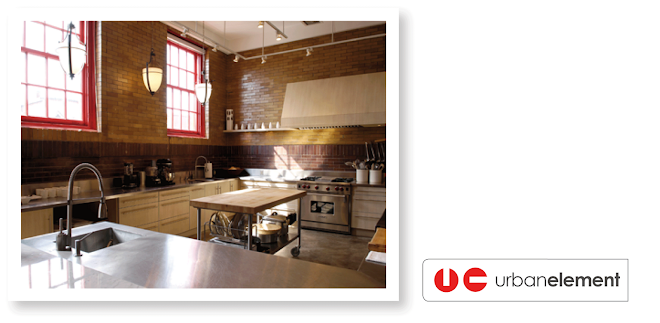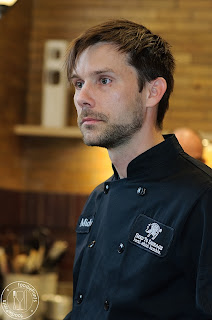Don Chow (of Ottawa's foodieprints:
a delicious blog that reveals stories about food, drink, cooking and eating in Canada's Capital) joined in on our Seed to Sausage cooking demonstration with Mike McKenzie in June. Below, Don shares with our readers his take on what makes for a good cooking class and captures a very tasty night in both visual and print. Thanks Don for sharing the evening with us!
There has been
much written about upstart salumi producer,
A Seed to Sausage, which is based out of Sharbot Lake in Southern Ontario. Its founder Mike McKenzie is recognized in restauranteur and chef entrepreneur circles from Montreal to Toronto. Such may have something to do with McKenzie's seeming cross-province speaking tour. Such may have something to do with Seed to Sausage's philosophy, "local, ethical, and humble."
McKenzie believes in being able to trace his products to "the seed" that grew the grass or grain on which livestock feed, hence "seed" to "sausage."
As much as possible, ingredients are locally-sourced from family farms. Meat tends to be purchased whole and antibiotic-free. Everything is made by hand in small batches.
Recently, Seed to Sausage was chosen by
Ace Bakery to participate in its
Artisan Incubator program, which is part of a
twentieth anniversary celebration. Judges felt McKenzie's love for his craft and unwavering commitment to quality can be tasted in his cured and smoked meats, especially his chorizo and saucisson sec.
McKenzie also believes in sharing the expertise he amassed, moving from hobby salumi-making to supplier for restaurants, fine food shops, and small-chain grocery stores. You will find him and his team teaching a series of workshops at their facility in Sharbot Lake. Everything from water and pressure canning to sausage-making is planned. In June, McKenzie will host sausage-making workshops out of the Cirillo’s Culinary Academy in Toronto (4894 Dundas Street W.) with Chefs Lynn Crawford and Lora Kirk. Crawford and Kirk own and operate the highly acclaimed
Ruby Watchco, located in between trendy Riverdale and Leslieville neighbourhoods. Being one of the 20 chosen Ace Bakery artisans, he also has Food Network segments to film.
On Monday evening, he taught an exclusive 12-person sausage-making course at
The Urban Element in Ottawa (424 Parkdale Avenue).
Owner Carley Schelck offers demonstration-based and hands-on cooking classes at her stylish learning kitchen, located in a renovated former fire station on Parkdale Avenue.
It was a good class.
So, what makes a good cooking class? the Urban Element's open concept kitchen is outfitted with several convection ovens, professional-grade ranges, ample refrigeration, and lengths of marble and granite counter-top that doubles as work surfaces for chocolate and pastry.
Level of Complexity
Schleck arranged for McKenzie to teach two courses; an in-depth one with advanced topics for members of the restaurant industry who already practice the craft of salting, smoking, and curing meat, which Michael Ruhlman rightly calls charcuterie; and a more introductory one for general enthusiasts who just want to learn sausage-making.
Staff
Schleck has cooks and servers available to support instructors. Both demonstration and hands-on classes include multi-course plates, paired with craft beer and wine. Cooks actively help with prep, plating, and cleanup. Servers serve and clear plates. Sometimes, for larger classes, Schelck's resident chef, Anna March, formerly of
Mariposa Farms is on-hand.
Duration and Pacing
Schleck works with instructors, usually restaurant chefs, to establish lesson plans. This way topics are scheduled so they can be delivered at a pleasant pace.
Participation
After having everyone attending his evening "general enthusiast" class introduce themselves, McKenzie asked us what we wanted to learn. Then, he tailored his class to match. Moreover, besides sharing much insight, McKenzie encouraged questions. Attendees ground meat and stuffed sausage casings, working with a grinder and stuffer. We made a batch of fresh sausage.
Cost
Urban Element courses tend to include a meal. For hands-on courses, materials (ingredients) and equipment are provided. When you consider the value-proposition, think "edu-tainment."
To summarize, good cooking classes convey expertise, share insight, and tell a compelling story.
Attendees were already familiar with Seed to Sausage, several big fans. Some were gifted the course on occasion of Father's Day.
Seed to Sasuage's Jalapeno Cheese Curd Smokies on Carrot Slaw
Seed to Sausage Charcuterie Tasting Plate; Hunters Salami, Northern Italian, Speck, Calabrese, Chorizo, and House Cured Ham
Some insight McKenzie shared:
- In order to ensure good "particle separation" (essentially well distributed meat, fat, and seasoning), ingredients need to be kept cold, so freeze as much of your equipment as you can; cut your meat into strips so the auger of the grinder can carry the meat through, eliminating the need to plunge the meat, which creates friction; chill your hands in ice water before handling the meat or mince; if you don't have separate equipment for grinding and stuffing sausage, you may need to let your grinder cool after it processes your meat.
- Minimize air pockets in your sausage. Air pockets can lead to bacterial growth.
- If you plan on making sausage-making a hobby, invest in disposable gloves meant for food handling. They make cleanup easier.
- When cleaning your meat grinder, feed bits of stale bread through.
- Let freshly made sausage age overnight. The ensures the meat binds with the casing, minimizing the risk of it escaping out of the ends of the sausage when cooked.

Cutting the Pork Butt into Strips
Grinding the Pork Butt
Putting the Sausage Mince Together
Stuffing Sausage Casings
"You'd be surprised. Three pairs of gloves can save your marriage when making sausage," explained McKenzie.
"When you make sausage, you don't need a lot of ingredients!"
Seed to Sausage's sausages tend to include 5 ingredients or less.
To cook his fresh sausages, McKenzie recommends heating them up in an oven set to 225F for 30-40 minutes.
The sausage we made included boneless pork shoulder, pickled jalapenos, cheese curds, crushed dried chiles, and salt (generally 2% by mass).
Good food! Engaging instructor! Great class!

















